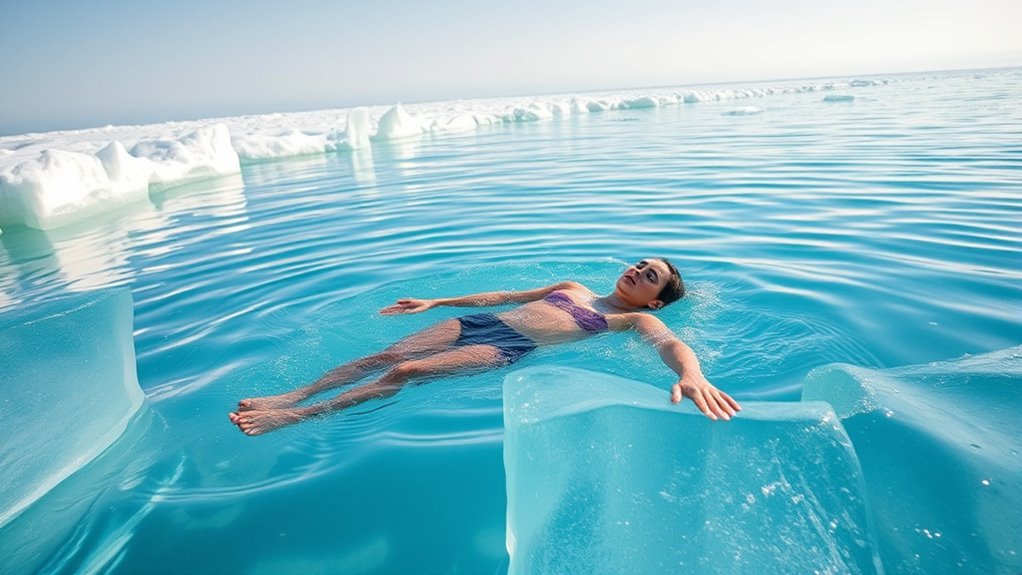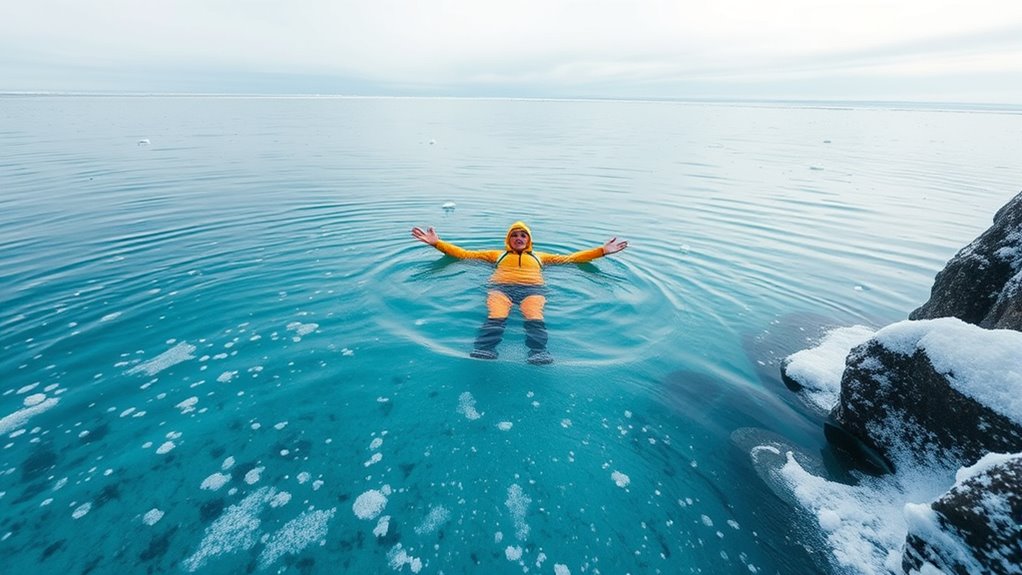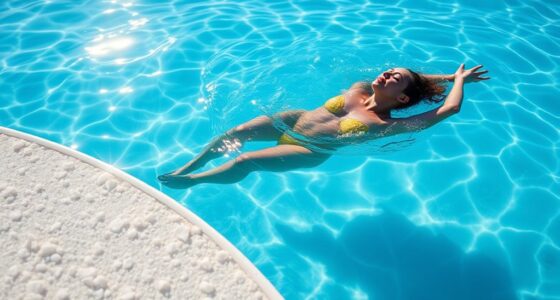Cold water floating offers sensations of effortless buoyancy and mental clarity, boosting mood and reducing stress through endorphin release. However, it’s essential to stay safe by wearing appropriate gear like wetsuits, floating with a buddy, and monitoring your body’s responses to avoid hypothermia or shock. Pushing beyond your comfort zone can be dangerous, so understanding the risks and safety measures is crucial. Keep exploring to learn how to enjoy this rejuvenating practice responsibly.
Key Takeaways
- Cold water floating promotes mental clarity and mood improvement through endorphin release and mindfulness, but safety precautions are essential.
- Wearing wetsuits or insulating gear reduces hypothermia risk during cold water immersion, especially for extended sessions.
- Always float with a buddy or trained professional nearby to monitor signs of hypothermia and ensure safety.
- Gradually build tolerance to cold water exposure to prevent shock and avoid overexposure that may lead to dangerous health effects.
- Recognize symptoms of hypothermia, such as dizziness and numbness, and have warm clothing ready to prevent cold-related health issues.

Have you ever wondered what it feels like to float effortlessly on cold water? It’s a unique sensation that can bring a profound sense of calm and connection to nature. But as appealing as it sounds, it’s vital to understand the risks involved, especially hypothermia risks. Cold water can sap your body heat rapidly, and even a few minutes of exposure can lead to dangerous drops in core temperature. That’s why proper preparation and safety measures are essential. Wearing a wetsuit or insulating gear can greatly reduce hypothermia risks, allowing you to enjoy the experience longer and more safely. Always monitor your body’s responses, and never push beyond your comfort zone or time limits.
Beyond the physical effects, cold water floating offers notable mental health benefits. Many people report feeling a boost in mood, reduced stress, and a clearer mind after immersing themselves in cold water. The shock of the cold triggers a rush of endorphins, which can alleviate symptoms of anxiety and depression. The act of floating calmly on cold water also encourages mindfulness, helping you stay present and centered. These mental health benefits aren’t just temporary; regular exposure can foster resilience and a more positive outlook. Additionally, understanding the lifecycle and performance metrics of cold water immersion devices can help optimize safety and effectiveness. However, it’s important to balance these benefits with safety. Cold water can be a shock to your system, so it’s wise to start gradually and build your tolerance over time.
As you venture into cold water floating, remember that your safety should always come first. Never go alone, especially if you’re new to cold water immersion. Have a buddy or a trained professional nearby who can assist if you start to feel unwell. Listening to your body is key—if you experience numbness, dizziness, or uncontrollable shivering, it’s time to get out and warm up. Keeping a warm towel or dry clothes nearby is a good idea, and always have a plan for quick rescue or assistance. Educate yourself about the signs of hypothermia, and respect your limits. Cold water floating can be a deeply rewarding experience when approached responsibly, offering both physical rejuvenation and mental clarity. Just make sure you’re prepared, cautious, and attentive to your body’s signals at all times.
Frequently Asked Questions
Can Cold Water Floating Help Improve Mental Health?
Cold water floating can boost your mental health by enhancing mental clarity and emotional resilience. As you immerse yourself, the shock stimulates your nervous system, helping you focus better and clear mental fog. Regular practice teaches you to stay calm under pressure, building emotional resilience. You might find that this experience reduces stress and anxiety, leaving you feeling more centered and better equipped to handle life’s challenges.
What Are the Long-Term Physical Effects of Regular Cold Water Floating?
Regular cold water floating can lead to long-term cardiovascular effects, strengthening your heart and improving circulation over time. It also promotes muscle adaptation, helping your muscles become more resilient and recover faster. You might notice increased stamina and reduced inflammation as your body adapts. However, it’s crucial to listen to your body and consult a healthcare professional if you have underlying health conditions to guarantee safe benefits.
Is Cold Water Floating Suitable for Children or Pregnant Women?
Cold water floating isn’t suitable for children or pregnant women due to age restrictions and health considerations. You should avoid it if you’re pregnant or have underlying health issues like heart conditions or respiratory problems. Always consult a healthcare professional before trying cold water activities. If you’re unsure, prioritize safety and opt for gentler, age-appropriate water experiences to reduce risks.
How Does Cold Water Floating Compare to Traditional Swimming?
Cold water floating offers a different experience than traditional swimming, focusing on relaxation, breathing techniques, and body adaptation. Unlike regular swimming, it emphasizes gentle, mindful movements and controlled breathing to help you stay calm. While traditional swimming involves active, vigorous movement, cold water floating encourages you to slow down and adapt to the temperature. This makes it a soothing, meditative practice that promotes mental clarity and physical resilience.
Are There Specific Clothing or Gear Recommendations for Cold Water Floating?
While the chill of the water might seem intimidating, you should consider wetsuit recommendations and safety gear options for cold water floating. A well-fitted wetsuit keeps you warm without restricting movement, and safety gear like a floatation device or waterproof thermal layers can enhance your safety. You might also want to carry a waterproof phone case and wear a hat or gloves to protect extremities, ensuring comfort and safety in cold conditions.
Conclusion
As you plunge into cold water floating, imagine yourself a leaf drifting serenely on a vast, icy lake—calm yet resilient. Embrace the chill as a invigorating dance with nature’s raw power, awakening your senses like a spark igniting a dark night. With respect and proper safety, you’ll find this icy voyage a revitalizing symphony for your body and mind. Immerse yourself confidently, and let the cold waters reveal your strength and resilience beneath their shimmering surface.










